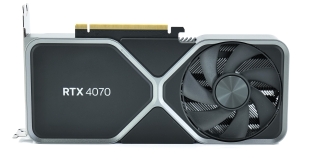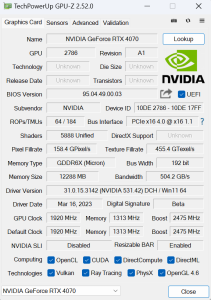
It's been a fairly slow few months in the consumer GPU space, with the RTX 4070 Ti being the last graphics card to hit the market back in January. That changes today however, as Nvidia is now ready to release the RTX 4070 (non-Ti). Offering a cut-down GPU die compared to the RTX 4070 Ti, the 4070 also comes in with a lower price-point of £589. We look at gaming performance, ray tracing, power draw, efficiency and much more in today's review.
The Nvidia RTX 4070 is the fourth Ada Lovelace GPU to hit shelves, with the launch of the 40-series flagship, the RTX 4090, now six months behind us. How time flies! It's essentially a cut-down RTX 4070 Ti, using the same AD104 silicon but with 23% fewer cores, though it shares the same memory subsystem, with 12GB GDDR6X VRAM.
Alongside the Nvidia Founders Edition, today we also take a look at the Gigabyte RTX 4070 Windforce OC, alongside the Palit RTX 4070 Dual. Both are targeting the £589 MSRP, so it'll be interesting to see how they stack up today. If you want to read this review as a single page, click HERE.
| RTX 4090 | RTX 4080 | RTX 4070 Ti | RTX 4070 | RTX 3080 | RTX 3070 Ti | |
| Process | TSMC N4 | TSMC N4 | TSMC N4 | TSMC N4 | Samsung 8N | Samsung 8N |
| SMs | 128 | 76 | 60 | 46 | 68 | 48 |
| CUDA Cores | 16384 | 9728 | 7680 | 5888 | 8704 | 6144 |
| Tensor Cores | 512 | 304 | 240 | 184 | 272 | 192 |
| RT Cores | 128 | 76 | 60 | 46 | 68 | 48 |
| Texture Units | 512 | 304 | 240 | 184 | 272 | 192 |
| ROPs | 176 | 112 | 80 | 64 | 96 | 96 |
| GPU Boost Clock | 2520 MHz | 2505 MHz | 2610 MHz | 2475 MHz | 1710 MHz | 1770 MHz |
| Memory Data Rate | 21 Gbps | 22.4 Gbps | 21 Gbps | 21 Gbps | 19 Gbps | 19 Gbps |
| L2 Cache | 73729 KB | 65536 KB | 49152 KB | 36864 KB | 6144 KB | 4096 KB |
| Total Video Memory | 24GB GDDR6X | 16GB GDDR6X | 12GB GDDR6X | 12GB GDDR6X | 10GB GDDR6X | 8GB GDDR6X |
| Memory Interface | 384-bit | 256-bit | 192-bit | 192-bit | 320-bit | 256-bit |
| Memory Bandwidth | 1008 GB/Sec | 716.8 GB/Sec | 504 GB/Sec | 504 GB/Sec | 760 GB/Sec | 608 GB/Sec |
| TGP | 450W | 320W | 285W | 200W | 320W | 290W |
First, for a quick spec recap. Just like the RTX 4070 Ti, RTX 4070 uses a cut-down AD104 die, measuring 295mm2. The fundamental building blocks are still the same of course, with the RTX 4070 offering a total of 46 Streaming Multiprocessors (SMs), each housing 256 CUDA Cores, for a total of 5888. We also find 46 RT cores, 184 Tensor cores, 184 Texture Units, and 64 ROPs.
TSMC's N4 node has Nvidia cranking up the clock speed significantly this generation, with the RTX 4070 sporting a 2475MHz rated boost clock. That's 135MHz slower than the rated clock speed of the RTX 4070 Ti however, but we would expect GPU Boost to push things further still.
The memory configuration is another area where AD104 has been cut-back significantly. The memory interface has been reduced to 192-bit, and even with 12GB GDDR6X running at 21Gbps, that brings total memory bandwidth down to 504 GB/s, lower than even the RTX 3070 Ti. That said, there has been a substantial upgrade to the L2 cache with the Ada architecture, with the RTX 4070 now offering 36.8MB, compared to just 6MB for GA102.
Considering these cut-backs, power draw is naturally lower than the RTX 4070 Ti, with the 4070 boasting a 200W TGP. This is something we focus on closely, using our updated GPU power testing methodology in this review, so read on for our most detailed power and efficiency testing yet.
Be sure to check out our sponsors store EKWB here
 KitGuru KitGuru.net – Tech News | Hardware News | Hardware Reviews | IOS | Mobile | Gaming | Graphics Cards
KitGuru KitGuru.net – Tech News | Hardware News | Hardware Reviews | IOS | Mobile | Gaming | Graphics Cards




